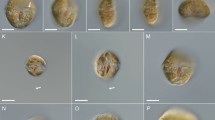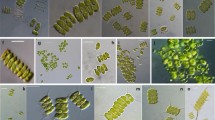Abstract
Hatena arenicola (Katablepharidophycota) is a single-celled eukaryote that temporarily possesses a chlorophyte alga of the genus Nephroselmis as an intracellular symbiont. In the present study, we investigated the molecular diversity of the endosymbiont Nephroselmis in a natural population of the host H. arenicola. We sequenced the host’s 18S rRNA gene and the endosymbiont’s plastid-encoded 16S rRNA gene. The results indicated that almost identical strains of the host harbored at least three distinct strains of the algal endosymbiont affiliated to the clade Nephroselmis rotunda. This finding supports our previous hypothesis that H. arenicola and its symbiotic alga are in an early stage of secondary endosymbiosis.


Similar content being viewed by others
References
Adl SM, Simpson AG, Farmer MA, Andersen RA, Anderson OR, Barta JR, Bowser SS, Brugerolle G, Fensome R, Fredericq S, James TY, Karpov S, Kugrens P, Krug J, Lane CE, Lewis LA, Lodge J, Lynn DH, Mann DG, McCourt RM, Mendoza L, Moestrup Ø, Mozley-Standridge SE, Nerad TA, Shearer CA, Smirnov AV, Spiegel FW, Taylor MFJR (2005) The new higher level classification of eukaryotes with emphasis on the taxonomy of protists. J Eukaryot Microbiol 52:399–451
Adl SM, Simpson AG, Lane CE, Lukes J, Bass D, Bowser SS, Brown MW, Burki F, Dunthorn M, Hampl V, Heiss A, Hoppenrath M, Lara E, le Gall L, Lynn DH, McManus H, Mitchell EAD, Mozley-Stanridge SE, Parfrey LW, Pawlowski J, Shadwick L, Schoch CL, Smirnov A, Spiegel FW (2012) The revised classification of eukaryotes. J Eukaryot Microbiol 59:429–514
Archibald JM (2009) The origin and spread of eukaryotic photosynthesis: evolving views in light of genomics. Bot Mar 52:95–103
Faria DG, Kato A, de la Peña MR, Suda S (2011) Taxonomy and phylogeny of Nephroselmis clavistella sp. nov. (Nephroselmidophyceae, Chlorophyta). J Phycol 47:1388–1396
Gibbs SP (1978) The chloroplasts of Euglena may have evolved from symbiotic green algae. Can J Bot 56:2863–2889
Hongoh Y, Sharma VK, Prakash T, Noda S, Toh H, Taylor TD, Kudo T, Sakaki Y, Toyoda A, Hattori M, Ohkuma M (2008) Genome of an endosymbiont coupling N2 fixation to cellulolysis within protist cells in termite gut. Science 322:1108–1109
Horiguchi T, Pienaar RN (1992) Amphidinium latum Lebour (Dinophyceae), a sand-dwelling dinoflagellate feeding on cryptomonads. Jpn J Phycol 40:353–363
Inouye I, Okamoto N (2005) Changing concepts of a plant: current knowledge on plant diversity and evolution. Plant Biotechnol (Tsukuba) 22:505–514
Katoh K, Misawa K, Kuma K, Miyata T (2002) MAFFT: a novel method for rapid multiple sequence alignment based on fast Fourier transform. Nucleic Acids Res 30:3059–3066
Larsen J (1988) An ultrastructural study of Amphidinium poecilochroum (Dinophyceae), a phagotrophic dinoflagellate feeding on small species of cryptophytes. Phycologia 27:366–377
Laval-Peuto M, Febvre M (1986) Review on plastid symbiosis in Tontonia appendiculariformis (Ciliophora, Oligotrichina). Biosystems 19:137–158
Lepere C, Demura M, Kawachi M, Romac S, Probert I, Vaulot D (2011) Whole-genome amplification (WGA) of marine photosynthetic eukaryote populations. FEMS Microbiol Ecol 76:513–523
Marin B, Melkonian M (2010) Molecular phylogeny and classification of the Mamiellophyceae class. nov. (Chlorophyta) based on sequence comparisons of the nuclear- and plastid-encoded rRNA operons. Protist 161:304–336
McManus GB, Zhang H, Lin S (2004) Marine planktonic ciliates that prey on macroalgae and enslave their chloroplasts. Limnol Oceanogr 49:308–313
Nishitani G et al (2010) High-level congruence of Myrionecta rubra prey and Dinophysis species plastid identities as revealed by genetic analyses of isolates from Japanese coastal waters. Appl Environ Microbiol 76:2791–2798
Okamoto N, Inouye I (2005) A secondary symbiosis in progress? Science 310:28
Okamoto N, Inouye I (2006) Hatena arenicola gen. et sp. nov., a katablepharid undergoing probable plastid acquisition. Protist 157:401–419
Paez JG, Lin M, Beroukhim R, Lee JC, Zhao X, Richter DJ, Gabriel S, Herman P, Sasaki H, Altshuler D, Li C, Meyerson M, Sellers WR (2004) Genome coverage and sequence fidelity of φ29 polymerase-based multiple strand displacement whole genome amplification. Nucleic Acids Res 32:e71
Pillet L, Pawlowski J (2013) Transcriptome analysis of foraminiferan Elphidium margaritaceum questions the role of gene transfer in kleptoplastidy. Mol Biol Evol 30:66–69
Pillet L, de Vargas C, Pawlowski J (2011) Molecular identification of sequestered diatom chloroplasts and kleptoplastidy in foraminifera. Protist 162:394–404
Stamatakis A (2006) RAxML-VI-HPC: maximum likelihood-based phylogenetic analyses with thousands of taxa and mixed models. Bioinformatics 22:2688–2690
Takishita K, Nakano K, Uchida A (1999) Preliminary phylogenetic analysis of plastid-encoded genes from an anomalously pigmented dinoflagellate Gymnodinium mikimotoi (Gymnodiniales, Dinophyta). Phycological Res 47:257–262
Tanabe AS (2011) Kakusan4 and Aminosan: two programs for comparing nonpartitioned, proportional and separate models for combined molecular phylogenetic analyses of multilocus sequence data. Mol Ecol Resour 11:914–921
Taylor FJR (1974) Implications and extensions of the serial endosymbiosis theory of the origin of the eukaryotes. Taxon 23:229–258
Yamaguchi H, Nakayama T, Kai A, Inouye I (2011) Taxonomy and phylogeny of a new kleptoplastidal dinoflagellate, Gymnodinium myriopyrenoides sp. nov. (Gymnodiniales, Dinophyceae), and its Cryptophyte Symbiont. Protist 162:650–667
Zhang L, Cui X, Schmitt K, Hubert R, Navidi W, Arnheim N (1992) Whole genome amplification from a single cell: implications for genetic analysis. Proc Natl Acad Sci USA 89:5847–5851
Zuker M (2003) Mfold web server for nucleic acid folding and hybridization prediction. Nucleic Acids Res 31:3406–3415
Acknowledgments
This work was supported by JSPS KAKENHI Grant Number 22657024 to T. N. and I. I., Grant Number 23117004 to I. I., and the NEXT program grant to Y. H. We thank Prof. Suda (University of the Ryukyus) for depositing the N. clavistella culture in NIES.
Author information
Authors and Affiliations
Corresponding author
Rights and permissions
About this article
Cite this article
Yamaguchi, H., Nakayama, T., Hongoh, Y. et al. Molecular diversity of endosymbiotic Nephroselmis (Nephroselmidophyceae) in Hatena arenicola (Katablepharidophycota). J Plant Res 127, 241–247 (2014). https://doi.org/10.1007/s10265-013-0591-1
Received:
Accepted:
Published:
Issue Date:
DOI: https://doi.org/10.1007/s10265-013-0591-1




